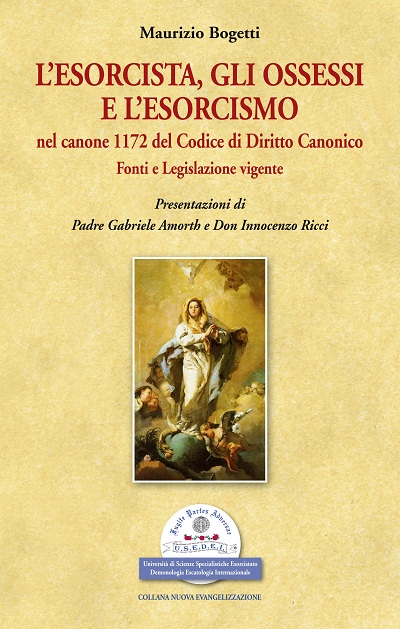L'ULTIMO LIBRO DI MAURIZIO BOGETTI SULL'ESORCISMO
Cari amici,
è in vendita il libro "L'esorcista, gli ossessi e l'esorcismo nel canone 1172 del Codice di Diritto Canonico. Fonti e legislazione vigente", con la collaborazione e presentazione di Padre Gabriele Amorth e l'introduzione di Padre Innocenzo Ricci.

DOWNLOAD:
POTETE ORDINARE IL LIBRO PRESSO:
1. L'EDITORE U.S.E.D.E.I. (consegne in Italia e all'estero):
(Università di Scienze Specialistiche Esorcistato Demonologia Escatologia Int.)
www.usedei.org - Email: Этот адрес электронной почты защищён от спам-ботов. У вас должен быть включен JavaScript для просмотра. - Tel. / Fax 011/79.35.535
Centro Editoriale: Via Prarostino 4 - 10143 TORINO
2. LA LIBRERIA DEL SANTO di Padova (consegne in tutta l'Italia):
www.libreriadelsanto.it - Email: Этот адрес электронной почты защищён от спам-ботов. У вас должен быть включен JavaScript для просмотра. - Tel. 049/860.33.53 - Fax 049.966.69.08
From: The Jurist: Studies in Church Law and Ministry
Volume 72, Number 1, 2012
pp. 313-314 | 10.1353/jur.2012.0001
This book offers a canonical, theological, and pastoral analysis of the sacramental of exorcism in the praxis of the Roman Catholic Church. The book focuses on the solemn exorcism of the possessed, recognized in Canon 1172 ( CIC-1983), in distinction from baptismal exorcism and other forms of exorcism such as the blessing of holy water. The book is divided into five major chapters. The appendices to the book include various rituals and other church documents pertaining to exorcism. The author, Maurizio Bogetti, has penned the book with bishops, exorcists, and priests in mind, but the book will also be of interest to all persons who confront the mystery of evil. Bogetti writes in response to a "hyper technologized, rationalist, and scientific society" which adopts a "pseudo-theology" assuming "the death of Satan."
Tracing the historical origins of exorcism to Judaism, Bogetti describes rabbinical exorcism as an antidote to "the practice of magic in pagan civilization." He notes that, in the Gospels, Jesus battles and conquers the ordinary and extraordinary manifestations of evil in order to liberate persons from "slavery to Satan." Ancient Christian authors such as Justin Martyr, Irenaeus, Tertullian, Cyprian of Carthage, Origen, and Martin of Tours all affirmed the significance of the practice of exorcism in the Church. In 416, Pope Innocent I decreed that the exorcism of a possessed person must be approved by the bishop. Bogetti also discusses various historical rituals for exorcism employed during the patristic, medieval, and post-Tridentine Church. The historical examination lays the groundwork for the author's commentary on the present day practice of exorcism.
In modern society, Bogetti recognizes that exorcism must be considered in relationship to medicine, psychiatry, and pharmacology. He reviews the classical signs of demonic possession recalling the instruction of the Church that medical diagnosis and treatment be attempted prior to the authorization of an exorcism. He observes that the entire process that leads to approval of an official exorcism must be enlightened by a correct "vision of Christian anthropology." The Christian understanding of the human person posits no necessary contradiction between science and faith. With regard to the office of exorcist in the diocese, Bogetti recalls that the exorcist must be a bishop or priest who is outstanding in holiness and integrity of life and who should have necessary preparation to fulfill the office. Observing that the exorcist would ordinarily use the rite for solemn exorcism approved by Pope John Paul II and promulgated in 1999, Bogetti comments that the diocesan bishop might also request permission from the Holy See for the exorcist to rely on the 1952 pre-conciliar rite. This book is guided by the principle that a solemn exorcism remains an extraordinary feature of the Church's prayer for deliverance from evil through the healing grace of Christ.
T1 - L'Esorcista, Gli Ossessi e L'Esorcismo, nel Canone 1172 del Codice di Diritto Canonico Fonti e...

